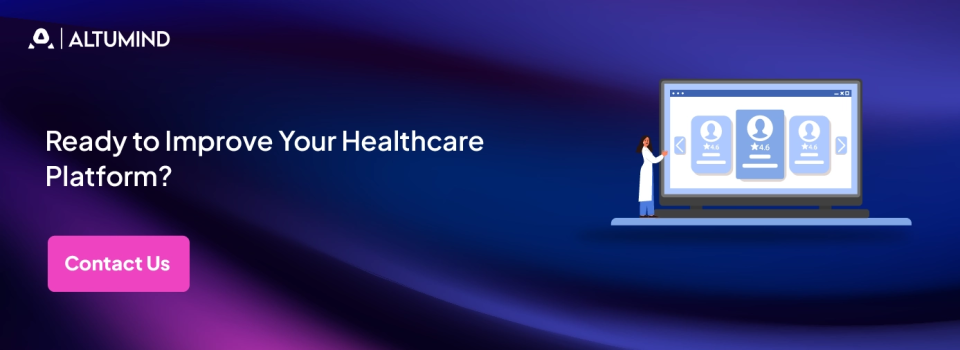How UX Design in Healthcare Shapes Efficiency and Better Patient Outcomes
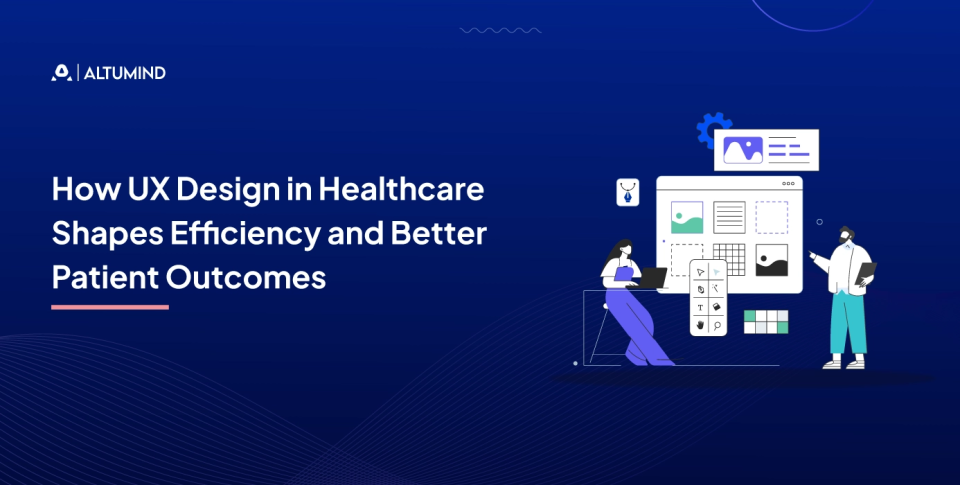
The United States healthcare system loses more than $8 billion annually due to inefficient digital systems. Poor interface design affects medical professionals and patients. This financial burden represents only one aspect of the challenge. Behind these numbers lie frustrated physicians, delayed treatments, and compromised patient safety.
UX design in healthcare changes on the basis of how patients interact with medical services and how providers deliver care. Digital health investments continue to rise, with the sector projected to reach $549 billion by 2028. Healthcare organizations must prioritize thoughtful interface design that places patients at the center of every interaction.
Understanding UX Design in a Healthcare Context
Defining Healthcare UX Design
User experience in healthcare refers to designing digital interfaces, systems, and processes that enable patients, clinicians, and administrators to accomplish health-related tasks efficiently and safely. The discipline involves creating intuitive navigation structures, clear information hierarchies, and accessible touchpoints that serve diverse user groups.
Unlike consumer applications, where poor usability frustrates users, healthcare interfaces carry significant consequences. A confusing medication dosage interface could lead to prescription errors. Unclear patient identification systems have resulted in wrong-site surgeries.
The Distinction Between Medical UX Design and General UX Design
| Aspect | Medical UX Design | General UX Design |
|---|---|---|
| Regulatory Compliance | Must adhere to strict frameworks, including HIPAA, GDPR, FDA guidelines, and WCAG accessibility standards. Every design decision requires documentation and validation against regulatory requirements. | Generally follows industry best practices and basic accessibility guidelines. Compliance requirements are typically less stringent with more implementation flexibility. |
| Authentication & Security | Requires robust multi-factor authentication, encryption protocols, and comprehensive audit trails. Security measures must protect sensitive health information and maintain detailed access logs. | Standard security measures with moderate protection levels. Implementation varies based on business needs and data sensitivity. |
| Stakeholder Complexity | Must simultaneously serve elderly patients with limited digital literacy, tech-savvy millennials, and physicians. Each user group has distinct needs requiring careful interface balancing and customization. | Typically focuses on a more homogeneous target audience. User needs and technical capabilities are generally aligned and predictable. |
| Data Visualization Standards | Clinical data must be presented with medical accuracy using standardized units and terminology. Visualization errors can lead to misinterpretation of life-critical health information. | Greater creative freedom in presenting data and information architecture. Design choices prioritize engagement and clarity without life-critical stakes. |
| Error Tolerance | Zero-tolerance environment where interface mistakes can cause medical errors or patient harm. Every interaction must include safeguards, confirmations, and clear error prevention mechanisms. | Errors typically result in user frustration or decreased engagement. Recovery mechanisms focus on user experience rather than safety-critical outcomes. |
| Design Decision Impact | Every interface element must be validated against clinical workflows and medical standards. Changes require extensive testing with healthcare professionals before implementation. | Design iterations can be more experimental with rapid A/B testing. Implementation cycles are faster with lower risk for exploratory changes. |
The Critical Importance of Patient-First Design
Direct Impact on Patient Safety and Clinical Outcomes
Research indicates that diagnostic errors contribute to 24,000 deaths annually in the United States alone. Interface design plays a documented role in these preventable tragedies. Electronic Health Record systems that obscure critical patient information lead to unperformed tests.
Studies examining 9,000 patient safety reports across three pediatric facilities revealed that 36% mentioned usability issues. Among these, 609 incidents potentially resulted in patient harm. These findings underscore that UX design healthcare principles directly influence clinical safety outcomes.
Usability Challenges and Their Effect on Performance
Poor usability forces healthcare organizations into constant firefighting. Hospitals often expand IT teams, hire additional trainers, and deploy workarounds to compensate for confusing interfaces. In healthcare, this challenge translates directly into lost time and clinician burnout. A national study of 2,067 family physicians published in JAMA Network Open found that only 27.2% were “very satisfied” with their Electronic Health Record (EHR) system, while 9.6% were “very dissatisfied.” Physician satisfaction was closely linked to the perceived usability of these systems.
Another large-scale analysis of 848 U.S. physicians reported a mean System Usability Scale score of 46.1 out of 100 for EHRs, compared with a general software benchmark of 68. This places EHR systems within the “not acceptable” range for usability and highlights how poor design and workflow alignment continue to erode productivity and morale across healthcare organizations. One more study suggested that, for every dollar invested in user experience, businesses realize potential returns up to $100, representing an ROI of 9,900%.
Core Principles of Effective Healthcare UX
Conducting Thorough UX Research in Healthcare
UX research in healthcare forms the foundation of successful digital health products. Research methodologies include ethnographic studies in clinical settings, contextual inquiries with frontline staff, and usability testing with representative patient populations.
Research must account for diverse user contexts. Emergency department physicians require different interface approaches than primary care providers scheduling routine appointments. Patients managing chronic conditions need monitoring tools distinct from those seeking acute care consultations.
Iterative testing in clinical environments reveals how real-world constraints affect usability. Interruptions, time pressure, cognitive load, and emotional stress all influence how healthcare professionals interact with systems.
Accessibility and Inclusive Design Standards
World Health Organization statistics indicate that over 1.3 billion people globally live with some form of disability, representing approximately 16% of the global population. Healthcare UX interfaces that fail to accommodate visual impairments, motor limitations, or cognitive differences exclude substantial user segments.
Accessible design requires compatibility with screen readers, voice controls, and text-to-speech tools. Navigation structures must function through keyboard commands alone. Color schemes need sufficient contrast ratios for users with vision impairments.
Elderly populations, who most frequently require healthcare services, face disproportionate challenges with complex digital interfaces. Age-appropriate design considers reduced dexterity, declining vision, and unfamiliarity with digital conventions.
Emerging Trends Shaping Healthcare UX in 2025
Artificial Intelligence Integration
Artificial intelligence is reshaping UX design in healthcare by enabling deeper personalization, predictive insights, and intelligent automation. AI-driven systems analyze patient interaction patterns to tailor dashboard layouts, highlight the most relevant clinical information, and deliver proactive health recommendations that support timely decision-making and improve overall care efficiency.
Chatbots powered by natural language processing offer preliminary triage, answer routine questions, and guide patients through symptom assessment protocols. The global AI healthcare market is projected to grow at a compound annual growth rate of 34.9%, approaching $77.2 billion by 2035.
However, AI introduces unique challenges. Systems occasionally generate responses without valid data sources. Healthcare applications require rigorous validation methodologies and continuous monitoring to prevent misinformation.
Telehealth and Remote Care Experiences
Following the pandemic, many Americans favored telemedicine services. By 2023, follow-up appointments accounted for 30% of all telehealth visits. Virtual care platforms have transitioned from emergency measures to permanent healthcare infrastructure.
Successful telehealth interfaces feel effortless. Mobile check-in processes, real-time video consultations, secure file sharing, and post-visit summaries must function with consumer-grade polish.
Poor telehealth experiences damage organizational reputation and patient retention. Clunky interfaces push patients toward emergency department visits for non-urgent concerns, increasing costs and system burden.
Wearable Device Integration and IoMT
The Internet of Medical Things continues rapid expansion, with connected device numbers projected to reach 75.98 billion by 2030. Wearables, including smartwatches, fitness trackers, glucose monitors, and specialized medical sensors, generate continuous health data streams.
Healthcare UX designers face the challenge of presenting this information meaningfully without overwhelming users. Interfaces must prioritize actionable insights over raw data dumps.
Integration between wearable devices and healthcare systems requires careful attention to data synchronization, privacy controls, and interoperability standards.
Key UX Benefits in Healthcare Applications
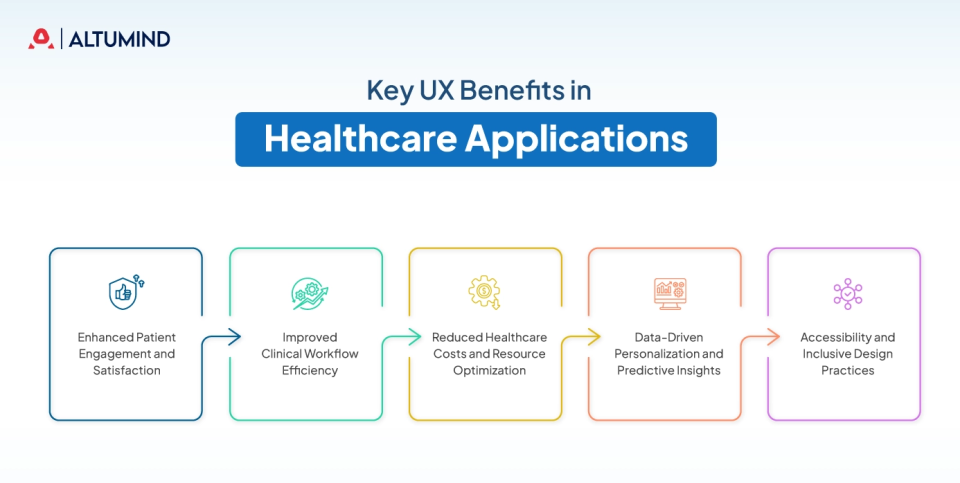
1. Enhanced Patient Engagement and Satisfaction
Patient-centered interfaces empower individuals to participate actively in their healthcare journey. Intuitive appointment scheduling, medication reminders, test result access, and educational resources increase engagement levels. Research indicates that 69% of patients would switch providers for better digital service experiences.
Platforms that simplify complex medical information through clear visualizations and plain language explanations help patients make informed decisions. Features supporting shared decision-making between patients and providers strengthen therapeutic relationships.
Satisfaction metrics correlate directly with interface quality. Patient portals with straightforward navigation and responsive design elements receive higher usage rates and more positive feedback.
2. Improved Clinical Workflow Efficiency
Well-designed clinical applications reduce documentation burden and allow providers to focus on direct patient care. Interfaces that surface relevant patient information contextually eliminate unnecessary navigation and repetitive data entry.
Configurable dashboards enable clinicians to customize their workspace according to specialty requirements and personal preferences. Emergency physicians require different information layouts than radiologists or oncologists.
Reduced cognitive load through clear information hierarchies and visual design principles minimizes medical errors. This represents one of the most significant UX benefits healthcare organizations realize from design investments.
3. Reduced Healthcare Costs and Resource Optimization
Efficient digital interfaces decrease operational expenses through multiple mechanisms. Automated appointment scheduling reduces administrative staff workload. Self-service patient portals handle routine inquiries without requiring phone calls.
Telemedicine capabilities, enhanced through effective UX design in healthcare, expand access to underserved populations while reducing facility overhead. Intuitive virtual care platforms remove transportation barriers for rural communities and individuals with mobility challenges, fostering a more inclusive and efficient model of care delivery.
Error prevention through good interface design avoids costly interventions, additional treatments, and potential liability issues.
4. Data-Driven Personalization and Predictive Insights
AI-powered systems enhance UX design in healthcare by tailoring digital experiences to individual needs. Predictive analytics interpret patient history, engagement behavior, and clinical data to deliver proactive recommendations and surface critical insights.
Personalized dashboards can highlight upcoming appointments, flag missed medications, and provide context-aware alerts that support timely interventions. When clinicians receive information aligned with their workflow, decision-making becomes faster and more accurate.
Such personalization not only improves outcomes but also builds confidence among both patients and providers. The result is a digital ecosystem that adapts continuously, ensuring every user interaction is meaningful, efficient, and grounded in data-driven intelligence.
5. Accessibility and Inclusive Design Practices
Accessibility remains a cornerstone of high-quality UX design in healthcare. Inclusive interfaces accommodate patients with diverse physical, visual, or cognitive abilities through voice-enabled navigation, adjustable contrast, scalable text, and screen reader compatibility.
These features make healthcare platforms equitable and compliant with WCAG and Section 508 standards. Multilingual support ensures that non-native speakers can navigate with clarity and confidence, reducing communication gaps in critical care scenarios. Beyond compliance, inclusivity reflects respect and empathy, values that enhance institutional reputation and patient loyalty.
When digital health platforms serve every user equally, they extend their reach, strengthen engagement, and turn technology into a true enabler of compassionate care.
Challenges in Implementing Healthcare UX Design
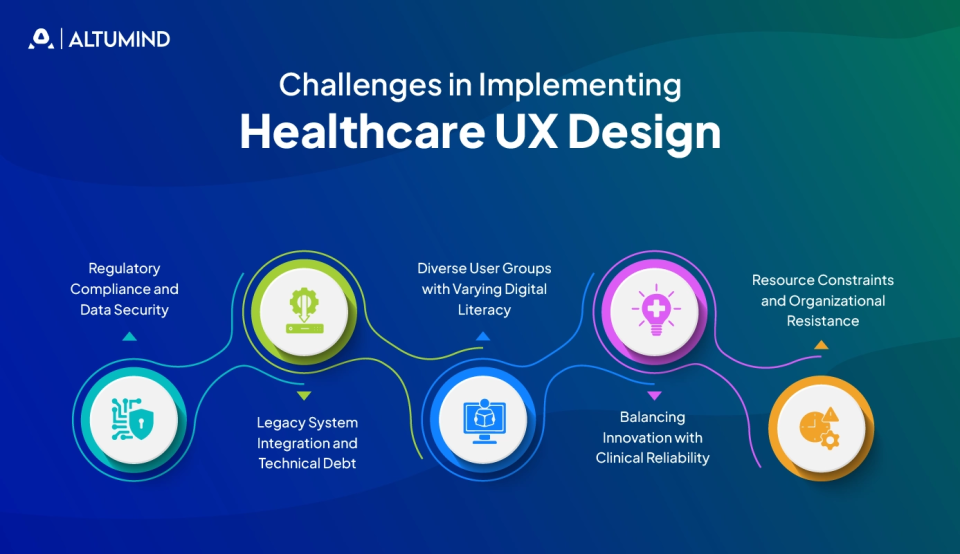
Regulatory Compliance and Data Security
Healthcare interfaces must navigate complex regulatory requirements that shape design decisions. HIPAA mandates specific data protection measures, including encryption, access controls, and audit logging.
Multi-factor authentication improves security but adds friction to login processes. Older patients and those with cognitive impairments may struggle with complex authentication flows.
GDPR introduces additional complexity for organizations serving international populations. Data residency requirements, consent management, and right-to-deletion provisions all influence architecture and interface design.
Legacy System Integration and Technical Debt
Healthcare organizations often operate decades-old Electronic Health Record systems that resist modernization. These legacy platforms enforce outdated interaction paradigms and technical constraints.
Interoperability challenges complicate integration between disparate systems using incompatible data formats. HL7 and FHIR standards help but do not eliminate compatibility issues.
Technical debt accumulates when organizations prioritize short-term feature additions over systematic design improvements.
Diverse User Groups with Varying Digital Literacy
Healthcare interfaces serve extraordinarily diverse populations. Technology adoption varies dramatically across age groups, socioeconomic backgrounds, and geographic regions.
Education level, language proficiency, and cultural context all influence how users interpret interface elements. Iconography, color symbolism, and interaction conventions differ across cultures.
Progressive enhancement strategies allow interfaces to serve users across the technical literacy spectrum. Core functionality works with minimal features and simple interactions.
Balancing Innovation with Clinical Reliability
Introducing new technologies into clinical environments requires balancing innovation with reliability. While modern UX approaches favor rapid iteration and experimentation, healthcare demands precision and consistency.
Unstable updates or poorly validated features can disrupt workflows and compromise patient safety. Design teams must collaborate closely with clinicians to validate usability under real-world conditions before deployment.
Rigorous testing protocols, including simulation-based assessments and pilot rollouts, help ensure that innovation does not outpace stability. The challenge lies in advancing digital capabilities while maintaining the trust and dependability essential in medical settings.
Resource Constraints and Organizational Resistance
Implementing strong UX design in healthcare often encounters financial and cultural barriers. Many healthcare organizations operate with limited budgets or prioritize clinical operations over digital transformation.
UX initiatives that require extensive user research, iterative testing, or cross-department collaboration may be viewed as nonessential expenses. In addition, resistance from staff accustomed to existing workflows can slow adoption.
Addressing these barriers requires leadership alignment, clear communication of ROI, and small-scale success stories that demonstrate measurable benefits. A gradual, evidence-based approach helps organizations recognize UX as a strategic investment rather than an optional enhancement.
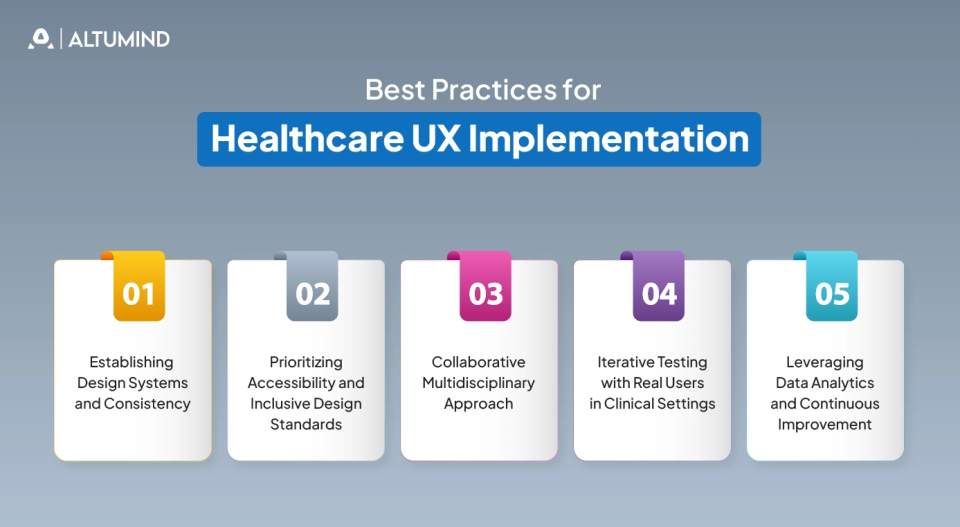
Best Practices for Healthcare UX Implementation
Establishing Design Systems and Consistency
Design systems provide reusable components, patterns, and guidelines that ensure consistency across healthcare applications. These systems reduce development time, minimize design debt, and create predictable experiences.
Component libraries include elements specifically designed for healthcare contexts, including medication lists, vital sign displays, appointment calendars, and clinical note templates.
Governance processes maintain design system quality as products evolve. Regular audits identify inconsistencies and opportunities for consolidation.
Iterative Testing with Real Users in Clinical Settings
Laboratory usability testing provides valuable insights but cannot replicate clinical realities. Testing in actual healthcare environments reveals how interruptions, time constraints, and stress affect usability.
Pilot programs with small user groups allow organizations to validate designs before full deployment. This reduces risk and provides opportunities to refine interfaces based on genuine feedback.
Collecting and analyzing usage data reveals patterns invisible through observation alone. Analytics showing where users struggle, abandon tasks, or require excessive time inform prioritization of improvement efforts.
Collaborative Multidisciplinary Approach
Successful medical UX design requires collaboration between designers, clinicians, IT professionals, compliance officers, and patients. Each perspective contributes essential insights that individual disciplines cannot provide alone.
Including frontline healthcare workers in design processes ensures solutions address real-world needs rather than assumed problems. Clinicians who participate in creating tools become champions for adoption among colleagues.
Regular cross-functional reviews maintain alignment between design vision and technical feasibility.
Prioritizing Accessibility and Inclusive Design Standards
Accessibility is essential to healthcare UX implementation, not an afterthought. Following WCAG and Section 508 guidelines ensures digital systems accommodate users with visual, auditory, or cognitive limitations.
Features such as keyboard navigation, screen reader support, adjustable contrast, and scalable text improve usability across diverse populations. Multilingual support and culturally neutral iconography promote clarity for patients from varied backgrounds.
Embedding accessibility from the earliest design stages prevents compliance issues and broadens the impact of digital healthcare tools.
Leveraging Data Analytics and Continuous Improvement
Continuous measurement sustains the effectiveness of healthcare UX over time. Analytics platforms track engagement metrics, workflow completion rates, and navigation efficiency to uncover usability gaps.
Quantitative insights, when combined with qualitative user feedback, support iterative refinement cycles. Heatmaps, funnel analyses, and task duration data identify where users lose time or encounter confusion.
Structured performance reviews after deployment ensure that updates improve clinical efficiency rather than introduce new complexity. Treating UX as a continuous optimization process keeps systems aligned with evolving user expectations and regulatory standards.
Real-World Applications and Use Cases
Electronic Health Record Systems
Modern EHR interfaces prioritize information hierarchy and contextual relevance over comprehensive data display. Instead of presenting all patient information simultaneously, effective designs surface relevant details based on clinical context and user role.
Smart defaults, predictive text entry, and voice dictation capabilities reduce documentation time. Templates customizable by specialty accommodate varying charting requirements across medical disciplines.
Mobile-optimized EHR interfaces allow providers to access patient information at the bedside or during hospital rounds.
Patient Portal Experiences
Patient portals serve as primary touchpoints between healthcare organizations and patients outside clinical encounters. Successful portals provide appointment scheduling, prescription refills, test result viewing, secure messaging with providers, and billing management.
Onboarding experiences must accommodate users with minimal digital health literacy. Progressive disclosure introduces features gradually rather than overwhelming new users.
Mobile-first design acknowledges that most portal access occurs through smartphones. Touch-friendly controls, simplified navigation, and reduced data entry requirements optimize the mobile experience.
Telemedicine and Virtual Care Platforms
Video consultation interfaces must feel reliable and professional while remaining accessible to non-technical users. Pre-visit device checks identify and resolve audio-visual problems before appointments begin.
Virtual examination tools, including screen sharing for reviewing images, symptom checkers, and remote monitoring integrations, extend physician capabilities beyond face-to-face video.
Post-visit documentation, including summaries, prescriptions, and follow-up instructions, helps patients retain information discussed during consultations.
The Future of UX Design in Healthcare
Predictive and Personalized Experiences
Future healthcare interfaces will anticipate user needs based on behavior patterns, health status, and contextual factors. Predictive design provides proactive reminders for patients who have not scheduled follow-up appointments.
Personalization extends beyond superficial customization to meaningful adaptation of content and functionality. Diabetic patients receive glucose monitoring tools and dietary tracking features. Cardiac patients see heart rate trends and exercise recommendations.
Machine learning algorithms identify patterns indicating declining adherence or emerging health concerns.
Voice and Conversational Interfaces
Voice-enabled healthcare applications provide hands-free access, particularly valuable for users with physical disabilities or limited dexterity. Natural language interfaces allow patients to schedule appointments, refill prescriptions, and access health information.
Voice technology must handle medical terminology accurately and understand context-dependent queries. Privacy considerations require careful implementation, and voice assistants accessing sensitive health information need robust authentication.
Conversational AI in healthcare must balance efficiency with empathy. Patients discussing symptoms or concerns require compassionate responses, even from automated systems.
Augmented Reality and Immersive Technologies
Augmented and virtual reality are technologies that transform medical training, surgical planning, and patient education through immersive experiences.
AR applications overlay diagnostic information during surgical procedures, improving precision and outcomes. Medical students practice procedures in virtual environments before working with actual patients.
UX research in healthcare design must address unique challenges in immersive environments, including motion sickness, spatial disorientation, and fatigue.
How Does Altumind AI Approach Healthcare UX Design?
At Altumind AI, we collaborate across multiple industries, with healthcare as one of our primary focus areas. Our team combines deep domain knowledge with user-centered design to address the complex realities of modern healthcare systems.
We integrate UX research in real clinical environments with iterative design processes and rigorous usability validation. Through ethnographic fieldwork, clinician interviews, and patient usability studies, we uncover insights that inform intuitive, compliant, and scalable digital solutions.
Our experience working with both enterprise-level healthcare networks and mid-sized providers enables us to create adaptable solutions that enhance care delivery, operational efficiency, and user satisfaction.
Conclusion
UX design healthcare solutions represent far more than aesthetic improvements or technological novelties. Thoughtful interface design directly influences patient safety, clinical efficiency, and healthcare quality. Organizations that prioritize patient-first digital experiences realize measurable benefits, including improved outcomes, increased satisfaction, reduced costs, and competitive differentiation.
The healthcare industry is undergoing rapid digital transformation. Patient expectations continue to rise as consumer technology sets new benchmarks for convenience and accessibility. Regulatory demands are becoming more intricate, requiring systems that ensure compliance without disrupting care. At the same time, clinical workflows now rely heavily on digital tools, making usability and efficiency central to effective healthcare delivery.
Healthcare organizations must move beyond treating healthcare UX as an afterthought to embedding it throughout product development processes. This requires investment in research, testing, specialized expertise, and iterative refinement.
At Altumind AI, we partner with healthcare organizations to navigate complex challenges and emerging opportunities. Through our specialized UI/UX services, we combine comprehensive research, evidence-based design, and rigorous validation to craft digital health experiences that truly serve both patients and providers.
Table of Contents
- Introduction
- Understanding UX Design in a Healthcare
- Medical UX Design Vs General UX
- The Critical Importance of Patient-First Design
- Principles of Effective Healthcare UX
- Trends Shaping Healthcare UX
- Key UX Benefits in Healthcare Applications
- Challenges in Implementing Healthcare UX Design
- Practices for Healthcare UX Implementation
- Real-World Applications and Use Cases
- The Future of UX Design in Healthcare
- Altumind AI Approach Healthcare UX Design
- Conclusion
Let's Connect
Reach out and explore how we can co-create your digital future!

